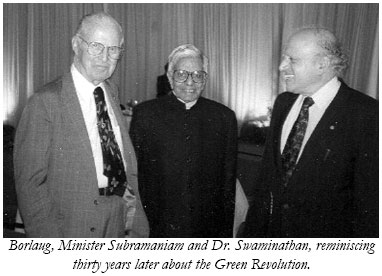| The
Green Revolution spreads to South Asia - Norman
Borlaug's "Kick-Off Approach"
Borlaug’s grand scheme for the campaigns was what he
called the “Kick-Off Approach,” which he based on
outright rejection of the hypothesis that agricultural
development of necessity has to be slow. His Kick-Off
Approach was founded on manipulating three
factors—technical, psychological and economic— in such a
way as to achieve rapid results. The technical factor
had already been proved to his satisfaction in the
results of the field trials. He now had to work on the
psychological and economic factors to get the required
policy changes.
Due to
drought, late sowing and poor germination, India’s
spring harvest in 1966 from approximately three thousand
hectares sown to Mexican wheat varieties, in half-acre
plots on thousands of farms, produced mixed results.
Many were good; a few were excellent. Borlaug, ever the
optimist, said, “With superb handling of supplementary
topdressing with nitrogen fertilizer and timely
application of irrigation, the seedlings tillered
profusely.” And indeed in many locations yields were
much better than any that had previously been recorded
in India. Norm said, “The Lady of Serendip had smiled
upon us, there was widespread enthusiasm, and euphoria
reigned in a few locations.”
At the
time, the drought and famine were at their worst in
northeast India, especially in Bihar and West Bengal.
Under
these dismal conditions, Minister of Food and
Agriculture Subramaniam made a courageous and historic
decision. Against the advice of several of his senior
scientists, he decided to import eighteen thousand tons
of the short-strawed, highyielding Lerma Rojo 64 seed
from Mexico.
About
the large import of seed, Norm says, “It unleashed a
flood of criticism, because of the risks involved, from
many academicians in ivory halls in affluent countries
from around the world. Shri Subramaniam and I were
charged by some critics with recklessly and
irresponsibly playing with the lives of millions of
people.”
In the
fall of 1966, approximately 240,000 hectares were
planted with seed of Mexican varieties. Before the
plantings were made, a great controversy developed, with
the economists from the Ministry of Agriculture, the
Planning Commission, and the Rockefeller Foundation,
including heavyweight David Hopper, on one side of the
issue and Borlaug and Glenn Anderson on the other.
Norm
recalls, “The economists insisted that we should cut
back the fertilizer application from 120-40-0 kilograms
per hectare of nutrients to 40-20-0 so that three times
more area and families could share the benefit of
fertilizer. We argued loudly and heatedly that this
scale-back in fertilizer recommendations was premature,
for we had not yet overcome the skepticism and
psychological barrier of the traditionalists, peasant
farmers, bureaucrats and senior scientists. At one
point, the debate became both emotional and heated. With
the diplomacy of Dr. Ralph Cummings, head of the
Rockefeller Foundation team in India, we finally calmed
down. We stood our ground and won the argument and the
heavy rate of fertilizer was applied on 240,000
hectares.” The dramatic results vindicated Borlaug and
Anderson. The Mexican seeds were the catalyst.
Fertilizer was the fuel. [...]
 Borlaug
informed those present of the outstanding success of the
wheat campaign and the enthusiasm of the farmers for the
new wheats and the associated package of production
technology. He closed by saying that if the government
of India now would adopt an economic policy that would
stimulate the adoption of the new technology, it could
trigger a revolution in wheat production. Borlaug
informed those present of the outstanding success of the
wheat campaign and the enthusiasm of the farmers for the
new wheats and the associated package of production
technology. He closed by saying that if the government
of India now would adopt an economic policy that would
stimulate the adoption of the new technology, it could
trigger a revolution in wheat production.
Borlaug
indicated that government action was needed to assure
-
the availability of the right kind of fertilizer at
reasonable prices at the village level six weeks
before the onset of the planting season;
-
credit for the farmers to purchase fertilizer and
seed before planting, to be paid back at harvest;
and
- an
announcement before the initiation of the planting
season that, at harvest, farmers would receive a
fair price for their grain.
He said
the price should be similar to that of the international
market rather than only half that price, as had
prevailed for decades under the cheap food price
policies that had prevailed since India’s independence.
[...]
Norm
left for Mexico four hours after the meeting. Two weeks
later he received from offices of the Rockefeller and
Ford foundations in New Delhi a series of clippings
dated April 1st from all the major New Delhi newspapers.
The clippings disclosed a drastic change in policies on
fertilizer on two fronts: the government would begin to
increase fertilizer imports for the short-term and would
embark on a dynamic program to expand domestic
fertilizer production. The subsequent increases in
availability and use of fertilizer contributed to
dramatic increases in food production. |